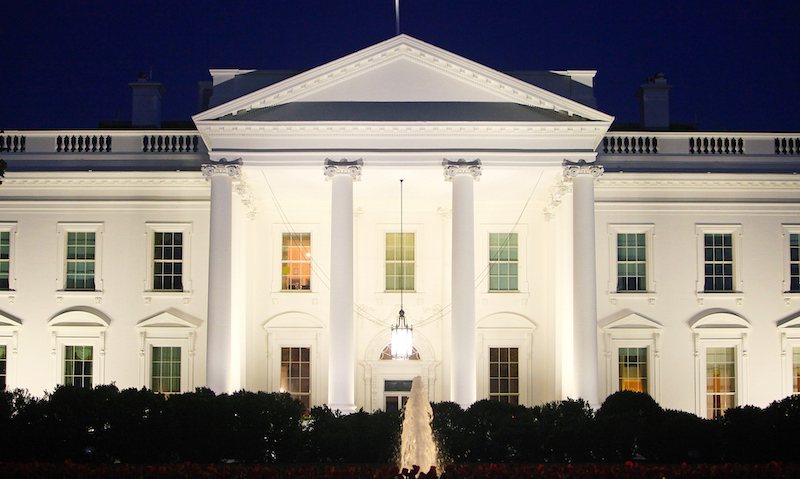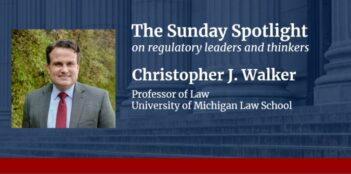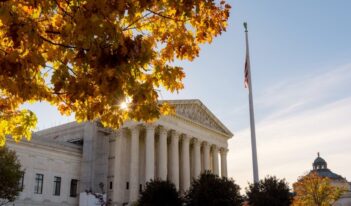
In a recent book, Cass Sunstein and Adrian Vermeule defend the administrative state against political threats and growing distrust.
Why would two stars of regulatory and constitutional theory take the stage to revive an old story about bureaucratic overreach that many thought had been relegated to a dusty academic shelf?
I am not talking about restoring a play by William Shakespeare or even Christopher Marlowe—but rather a revival of someone like Richard Sheridan, an Irish satirist best known for his novel The School for Scandal. Satire turns out to be the muse for Cass Sunstein and Adrian Vermeule, the authors of Law and Leviathan, even though they deal with a very serious subject in the book: the structure of modern government.
In their first chapter, Sunstein and Vermeule introduce us to “the new Coke,” which is “shorthand for a cluster of impulses stemming from a belief in the illegitimacy of the modern administrative state.” The old Coke was Sir Edward Coke, who—as a common law judge—stood in opposition to the Stuart dynasty’s despotic use of the prerogative writ, a collection of special legal privileges afforded to the monarch.
The new Coke comprises recent scholarship elevating common law judges to savior status by setting them against the assertedly new prerogative writ—that is, the discretionary orders that various agents of the administrative state routinely issue.
This new Coke, as Sunstein and Vermeule cleverly describe it, warrants putting more “fizz” into the defense of the bureaucracy. As a beverage, the actual new Coke was such a marketing disaster that the Coca-Cola Company quickly replaced it with the old formula. The recent criticisms of the administrative state are also disastrously flawed. Perhaps the more accurate label might be Coke Zero, which seems to fit better with Sunstein and Vermeule’s views about their critical value.
For Sunstein and Vermeule, the answer to worries about Stuart despotism—or, more relevantly Roscoe Pound’s administrative absolutism—is not a return to rule by common law judges, but rather the incorporation of statutory, regulatory, and judicial mandates that have brought due process and procedural regularity to the administrative state. Though they do not engage in historical analysis, Sunstein and Vermeule’s ideas are supported by the events of the post-Stuart period.
For William of Orange to ascend to the throne, he had to marry a Stuart (Mary II) and submit to the English Bill of Rights, thereby becoming the first constitutional monarch as part of the Glorious Revolution. Appropriately, John Locke, a source of the U.S. Constitution’s Due Process Clause, was William and Mary’s confidant and political secretary.
The end to Stuart despotism was therefore not left to the judges but was put in the hands of the English Parliament when it constrained executive power and introduced procedural protections—although admittedly not bureaucratic ones.
As England survived its Stuart period, so too has the United States survived its neo-Stuart period under President Donald J. Trump, the author of numerous ukase-like executive orders.
For Sunstein and Vermeule, the key modern statute that helps ensure bureaucratic justice is the Administrative Procedure Act (APA) of 1946. They highlight Justice Robert Jackson’s opinion in Wong Yang Sung v. McGrath, in which the U.S. Supreme Court stated that the APA settled “long continued and hard fought contentions by enacting a formula upon which opposing social and political forces have come to rest.”
Justice William Rehnquist reemphasized this declaration in Vermont Yankee Nuclear Power Corp. v. Natural Resources Defense Council, making the APA something of a “super statute”—or, as Sunstein recently stated, “a mini constitution for the administrative state.”
Although the APA is one of the ways that the rule of law has been transferred to the administrative state, it is also true that the APA’s effect has been—to some degree—symbolic since its formal adjudication provisions are limited in application, and its innovative rulemaking provisions are bare bones. Sunstein and Vermeule know this, so they have done a deeper and broader analysis of Leviathan’s legitimacy.
In a truly innovative exercise, they have transferred Lon Fuller’s work on the morality of law to the bureaucracy and to administrative law. For Fuller, the essence of the internal morality of law is one of established rules that are transparent, known, comprehensive, and stable (that is, not retroactive). Law and Leviathan redeems the administrative state by showing how established legal principles, in familiar cases creatively arrayed, pass all the tests of Fuller’s legal morality.
In situations where the morality of law and prevailing administrative law doctrines do not exactly match, Sunstein and Vermeule provide “surrogate safeguards.” One direct safeguard that administrative law does not provide is the opportunity to have initial decisions made by a common law or federal judge. But the APA provides surrogate safeguards through independent protections for administrative law judges and judicial review.
In addition, Sunstein and Vermeule emphasize that appellate court review is an essential part of administrative law. There is no need to replay all the cases and doctrines they discuss—including perennials such as Auer v. Robbins and Chevron v. Natural Resources Defense Council—but Sunstein and Vermeule’s take on the revival of the nondelegation doctrine is worth emphasizing.
Buttressed by Justice Neil Gorsuch’s opinion in Gundy v. United States, which attacks the nondelegation doctrine’s intelligible principle test, a potential majority of the Supreme Court (even before Justice Amy Coney Barrett’s ascension) now seems prepared to restore the nondelegation doctrine that was part of the New Deal Era. That doctrine provides the basis for judicial intervention in the administrative state on which the Stuart-redux scholars such as Philip Hamburger have pinned their hopes.
Sunstein and Vermeule are surprisingly confident, however, that the Court will not reinstate the nondelegation doctrine. The authors say it has no basis in the U.S. Constitution, but they also believe Fullerian principles provide “second order strategies,” such as process solutions under the APA’s arbitrary and capricious clause, that will obviate the need for what might be considered administrative law’s nuclear option. Although I admire their confidence, they may be coaxing the Court away from the precipice, since five Justices may find it irresistible to try out a new theory of nondelegation.
In reading Law and Leviathan, I initially wondered why it was so urgent to mount a defense of the administrative state at this time. After all, Justice Jackson assured us that the APA reflected a “formula upon which opposing political forces have come to rest.”
But then I got the point: Are those forces still at rest? Surely not.
Sunstein and Vermeule cite Justice Jackson as a reminder. The United States today is again living in an “age of anxiety” about its institutions and political leadership, much as in the New Deal period. President Trump was a norm-shattering President who, by happenstance and deviousness, appointed three Justices to create a Supreme Court majority with radical ideas about governance.
Sunstein and Vermeule are right to be alarmed, and they are not alone.
By providing a sophisticated defense of the administrative state, they have joined with other renowned scholars, such as James Freedman and Jerry Mashaw, who earlier tried to explain and deepen the public’s understanding of regulation and administration.
Freedman, in his book Crisis and Legitimacy, sought to assure the public that the administrative state was a legitimate enterprise, crises notwithstanding. Mashaw, in Bureaucratic Justice, attempted something even harder: convincing the public that bureaucracy could even have a positive connotation—that is, “bureaucratic rationality.”
Sunstein and Vermeule are also heirs to the great scholars of the New Deal, including Walter Gellhorn, Ken Davis, Louis Jaffe, and Carl McFarland. They are connected to them by a common adversary: Roscoe Pound. In decrying “administrative absolutism,” Pound led an American Bar Association effort to judicialize the administrative state under the Walter-Logan bill.
President Franklin Roosevelt vetoed the bill, and, after World War II ended, the APA took its place. The Walter-Logan bill is what the current opponents to the administrative state seem to want—judges employed to contain Leviathan, or a new Coke to thwart the new New Deal.
Remembering this legislative opposition gives Law and Leviathan a back-to-the-future quality, one in which the ghost of Roscoe Pound reappears, and the Four Horsemen of the Supreme Court are preparing to ride again.
When Chief Justice John Roberts refers to the “the headless fourth branch,” the fifth Justice in the form of the headless horseman appears, and the circle is complete. Perhaps Washington Irving, whose “The Legend of Sleepy Hollow” is the most memorable headless horseman story, should serve as the inspiration for Law and Leviathan.
Though the Biden Administration is now in office, the United States cannot forget just how radical the administrative law ideas of the Trump Administration were.
For example, in Executive Order 13,924, President Trump directed agency heads to “consider the principles of fairness in administrative enforcement and adjudication.” The Ray Memorandum, which implemented the order, listed principles—such as prompt and fair enforcement, clear and public rules of evidence, and enforcement free of unfair surprise—all of which Sunstein and Vermeule would agree with and can be found in the APA itself.
But the focus on regulatory fairness, although presented in a neutral fashion, was directed at slowing down and even obstructing the enforcement process itself. This feature presents the other side of the problem for bureaucracy: how to achieve results.
Emphasis on process is necessary for the government to satisfy the rule of law, but at some point, process can stifle the enforcement function. Sunstein and Vermeule leave this concern aside because they seek to defend and save the administrative state—not perfect it. They are not on a similar kind of mission as Mashaw in Bureaucratic Justice, in which effectiveness of decision-making was the goal.
The Trump Administration realized that process can be both a sword and a shield. Used offensively, it can achieve substantive goals. The Ray Memorandum, for instance, seems designed to add process to agency adjudications to make it easier for regulated entities to escape enforcement actions.
But the memorandum also contained an irony: If it applied to all executive agencies’ decisions, the process protections could have effectively strengthened the rights of those who appear before adjudicators outside the formal adjudication requirements of the APA.
Actions that rely on informal procedures—such as those before immigration judges or those involved in government benefits cases such as food stamp matters—are deficient in process protections for claimants. To strengthen them procedurally—despite slowing regulatory cases—would certainly mesh with Sunstein and Vermeule’s theme of morality in administrative law.
In another executive order on “Creating Schedule F in the Excepted Service,” President Trump sought to deprive non-adjudicatory career professionals “in positions of a confidential, policy-determining, policy-making or policy-advocating character” from the protections of civil service tenure. If these professionals had been put in the excepted service, the government could have removed any of these employees if they did not “display appropriate temperament, acumen, impartiality and sound judgment.”
Even though President Joe Biden revoked this order on his second day in office, it still bears attention. The notion that professional civil servants—who perform policy roles—can be removed from office is destructive of objective and competent government. Retribution was a familiar executive action of President Trump, and the United States must not forget how important truth-telling civil servants were then and will be in the future.
Although Law and Leviathan is focused on the rulemaking and adjudicative side of administration—the traditional territory of administrative law—its message should not stop there. If policy officials become essentially at-will employees, as they have in many states, how can the government be counted on to ensure independent judgment by those who adjudicate, make, and oversee rules?
Sunstein’s former agency, the Office of Information and Regulatory Affairs (OIRA), could hardly meet its goal to be a fair and independent overseer if its staff were not tenure protected. What gives OIRA and similar oversight agencies their credibility is that they are honest brokers, even while being bureaucrats with a purpose. Mashaw’s idea of bureaucratic rationality relies in substantial part on the integrity of the bureaucrats. Civil service protections assure us that policy officials cannot be removed simply for good-faith disagreements with superiors.
Removal without cause would also bury the actual reasons for decisions—reasons that may not be revealed as pretexts for unlawful whistleblower retaliation through investigations by the Office of Special Counsel or investigative journalists. In addition, at-will removal makes the prospect of government employment that much more undesirable.
In the end, Law and Leviathan reveals that the internal morality of administrative law has broad application. In their last chapter, Sunstein and Vermeule state that “the exercise of broad discretionary authority is under fundamental assault, not only in the political process but also as a matter of constitutional law.” They recognize that the attack on administrative law has both political and judicial dimensions but also that its impact goes beyond law in any strict sense.
The solutions to the legitimacy of the administrative state must revolve around subjective values such as integrity, truth telling, and matters of morality in government as well as administrative law. Political changes can be made at the ballot box, but judicial changes evolve more slowly and require compelling argumentation, which Sunstein and Vermeule provide in compelling detail. The judiciary will ultimately rate their arguments, hopefully with open minds.
The political task, however, will be harder to fulfill. To say that elections do not change minds seems almost fatuous when losers assume the role of insurrectionists. The public’s distrust of big government remains an attractive political trope—a kind of last refuge or go-to concept ready made for disrupters.
Law and Leviathan suggests a whole-of-government approach to the internal morality proposition. Administrative law provides the setting, but political officials, civil servants, and the field of public administration as well as law, are all players. By reviving basic principles of our democratic policy, Sunstein and Vermeule have offered a wider consideration of the administrative state’s legitimacy during as urgent a time in the history of the U.S. republic as any that came before.




